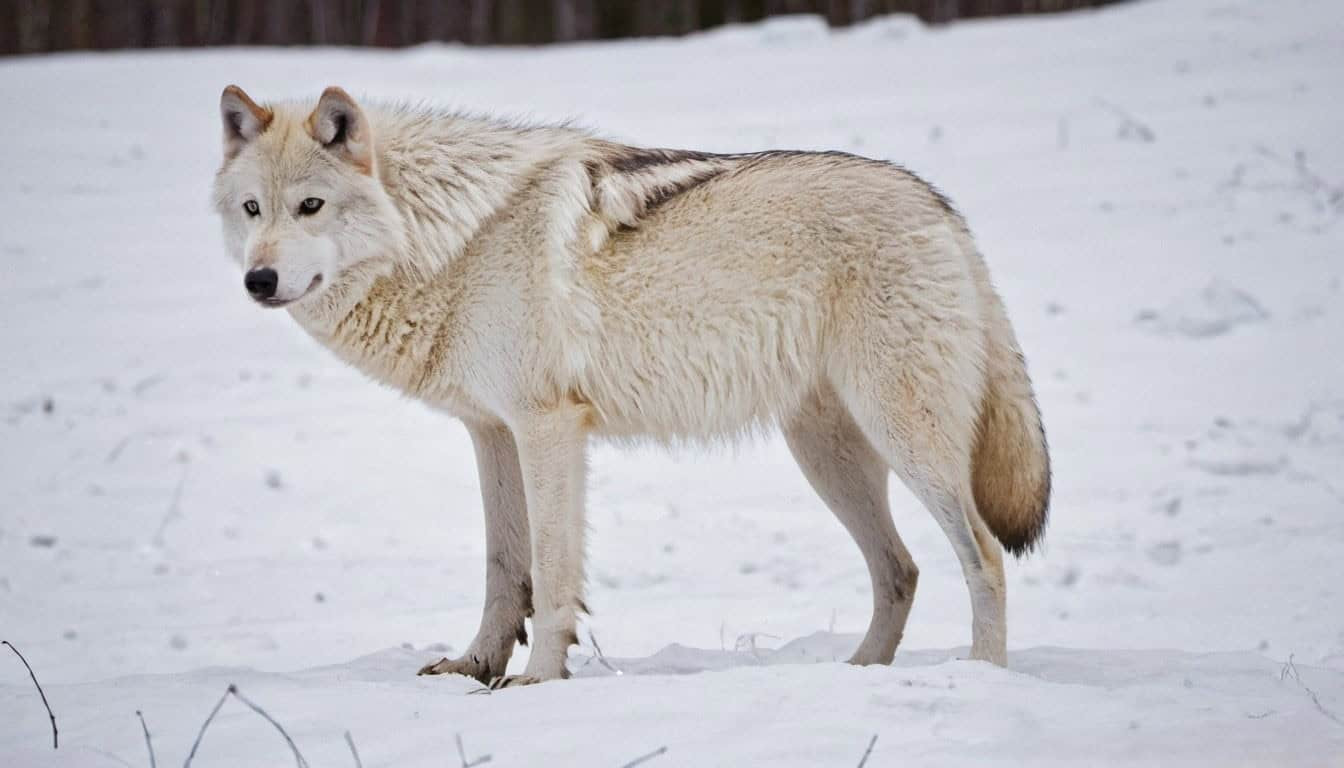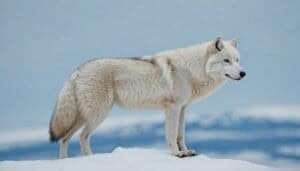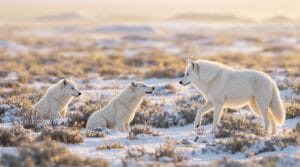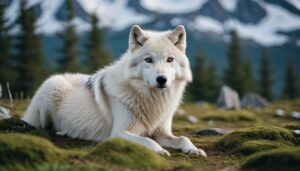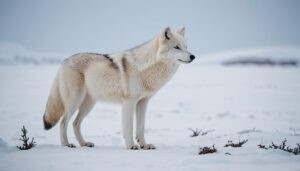Introduction
Arctic wolves face extreme challenges in their harsh, icy habitats, especially during periods of food scarcity. This article explores how these resilient predators cope with limited food resources
We’ll delve into their hunting techniques, physical adaptations, pack dynamics, and how seasonal changes impact their food supply. Additionally, we’ll examine their competition with other predators, the influence of climate change, and the effects of human activities on their survival
Finally, we will look into the reproductive success of Arctic wolves during scarce periods and ongoing conservation efforts to support their populations
How Arctic Wolves Survive Food Scarcity
Arctic wolves have developed various strategies to endure periods of food scarcity in their harsh environment. These adaptations and behaviors are crucial for their survival in the icy Arctic regions
Primary Hunting Techniques of Arctic Wolves
Arctic wolves primarily rely on their keen hunting skills to find food. They hunt in packs, which increases their chances of catching prey, especially larger animals. One of their main hunting techniques involves teamwork and coordination. Wolves communicate using vocalizations and body language to organize their hunts
The most common prey for Arctic wolves includes musk oxen, Arctic hares, and caribou
Hunting large prey like musk oxen requires strategy and cooperation among pack members. Wolves often target weaker individuals, such as the young, old, or sick, to increase their hunting success. During a hunt, some wolves distract the prey while others attack from the sides or rear, making it difficult for the prey to escape
In times of scarcity, Arctic wolves may also resort to hunting smaller animals, such as birds and rodents. This flexibility in diet helps them survive when larger prey is not available
Additionally, wolves are known to scavenge carcasses left by other predators or those that have died from natural causes, which provides an important food source during lean times
Physical Adaptations to Food Scarcity
Arctic wolves possess several physical adaptations that help them cope with food scarcity. Their thick fur provides insulation against the cold, reducing the amount of energy they need to maintain body temperature. This energy conservation is crucial during periods when food is scarce
Another adaptation is their ability to store fat. During times of abundance, Arctic wolves build up fat reserves, which they can draw upon during periods of scarcity. This fat acts as an energy buffer, allowing them to survive for extended periods without food
Studies have shown that Arctic wolves can survive for weeks without eating, relying on their fat reserves to sustain them
Their powerful sense of smell also aids in locating food. Arctic wolves can detect prey from great distances, even through deep snow. This heightened sense of smell helps them find hidden prey or carcasses that may be buried under the snow
Role of Pack Behavior in Food Shortage
Pack behavior plays a significant role in how Arctic wolves cope with food scarcity
Living in a pack provides several advantages, especially during hard times. The social structure of the pack ensures that food is shared among members, which helps individuals survive periods of scarcity
When food is limited, pack members may display cooperative behaviors, such as sharing food and caring for the young. The alpha pair, usually the dominant male and female, often lead the hunts and ensure that food is distributed fairly among the pack. This cooperation and sharing are vital for the survival of the pack as a whole
Pack dynamics also influence hunting success. With more wolves participating in a hunt, the likelihood of a successful kill increases. Each member of the pack has a role, whether it’s tracking, chasing, or bringing down the prey. This division of labor makes hunting more efficient and effective
Seasonal Changes and Food Availability
Seasonal changes significantly impact the availability of food for Arctic wolves. During the harsh winter months, food is often scarce due to the migration of prey animals like caribou. In contrast, summer offers more abundant food sources as prey animals return and the environment becomes more hospitable
Arctic wolves have adapted to these seasonal changes by altering their hunting strategies. In winter, they may follow migrating prey or target animals that remain in the area, such as musk oxen. The ability to adapt their diet and hunting techniques to the changing seasons is crucial for their survival
During summer, Arctic wolves take advantage of the increased food availability to build up their fat reserves in preparation for the leaner winter months. This seasonal cycle of abundance and scarcity dictates their feeding and hunting behaviors, ensuring they are better prepared to cope with the challenges of their environment
Main Prey and Competition
Understanding the main prey species of Arctic wolves and their competition with other predators is crucial to comprehending how these animals manage food scarcity. Their survival hinges on their ability to efficiently hunt available prey and compete successfully with other species in their harsh environment
Main Prey Species During Scarce Periods
Arctic wolves primarily prey on large mammals, which provide the necessary caloric intake to sustain them through periods of food scarcity. The most significant of these are musk oxen and caribou
Both species are well adapted to the Arctic environment, but they pose different challenges for the wolves:
Musk Oxen: Musk oxen are formidable prey due to their size, strength, and defensive behavior
They form protective circles with their horns facing outward when threatened, making it difficult for wolves to isolate an individual. Arctic wolves often target young, sick, or older musk oxen that are less capable of defending themselves. This strategy minimizes the risk and energy expenditure involved in hunting these large animals
Caribou: Caribou, on the other hand, are migratory and their availability varies with the seasons
During migration, caribou travel in large herds, which can make hunting challenging. However, Arctic wolves exploit the vulnerabilities of these herds by targeting individuals that lag behind, are injured, or are very young. Caribou calves are particularly vulnerable during the spring when they are born, providing a crucial food source for wolf packs
Arctic Hares and Smaller Prey: In addition to these large mammals, Arctic wolves also hunt smaller animals like Arctic hares, birds, and lemmings, especially when larger prey is scarce
These smaller prey species require different hunting tactics, often involving more stealth and agility. Arctic hares, for instance, are fast and well-camouflaged, so wolves must rely on surprise and speed to catch them
Competing With Other Predators
Competition for food is a significant challenge for Arctic wolves, as they share their habitat with other predators. Understanding these interactions provides insight into the wolves’ survival strategies during periods of food scarcity:
Polar Bears: Polar bears are the most formidable competitors, especially for larger prey like seals
While Arctic wolves do not typically hunt seals, the presence of polar bears can reduce the availability of other prey animals in the area. Wolves may avoid areas frequented by polar bears to minimize direct competition and potential conflict
Red Foxes: Red foxes, although smaller, are also competitors, particularly for smaller prey like lemmings and birds
During times of scarcity, the overlap in diet can lead to increased competition. Arctic wolves often have the advantage due to their size and pack hunting tactics, but red foxes can exploit their agility and smaller size to access prey in areas less accessible to wolves
Scavenging and Carcass Utilization: Arctic wolves are opportunistic feeders and will scavenge carcasses left by other predators or those that have died from natural causes
This scavenging behavior reduces direct competition for live prey and allows wolves to exploit a wider range of food resources. The presence of other predators can indirectly benefit wolves by increasing the availability of carcasses
Energetic Needs During Scarcity
The energetic needs of Arctic wolves vary with the seasons and the availability of food. During periods of scarcity, wolves must optimize their energy expenditure to ensure survival:
Energy Conservation: Arctic wolves conserve energy by minimizing unnecessary movement and physical exertion. They spend more time resting and staying close to their dens during extreme weather conditions to reduce caloric burn. This conservation strategy is crucial when food is not readily available
Metabolic Adaptations: Studies have shown that Arctic wolves can lower their metabolic rates during times of food scarcity
This physiological adaptation allows them to survive longer periods without food by reducing their energy requirements. The ability to enter a state of low metabolic activity is a key survival mechanism in their harsh environment
Feeding Hierarchy: Within a wolf pack, a feeding hierarchy exists that ensures the most critical members, such as the alpha pair and the pups, receive food first
This hierarchical feeding order maximizes the survival chances of the pack’s future generations, ensuring that even during scarce periods, the pack can maintain its social structure and continuity
Environmental and Behavioral Adaptations
Arctic wolves have evolved various environmental and behavioral adaptations to cope with food scarcity and thrive in their challenging habitat. These adaptations help them endure the extreme conditions of the Arctic and ensure their survival during periods when food is limited
Impact of Climate Change
Climate change poses a significant threat to Arctic wolves by altering their habitat and the availability of their prey. As temperatures rise and ice melts, the ecosystems that Arctic wolves rely on are changing, impacting both the wolves and their prey:
Shrinking Habitat: The Arctic tundra is experiencing a reduction in the extent and duration of sea ice, which affects the hunting grounds and migratory patterns of prey species like caribou and musk oxen
As the ice retreats, wolves are forced to cover larger distances to find food, increasing their energy expenditure and reducing their chances of survival
Changing Prey Availability: Climate change also affects the abundance and distribution of prey species. For instance, warmer temperatures can lead to changes in vegetation, impacting the food supply for herbivores like caribou and musk oxen
This, in turn, affects the wolves that depend on these animals for sustenance. Additionally, unpredictable weather patterns and extreme events can lead to higher mortality rates among prey species, further reducing food availability for Arctic wolves
Increased Competition: As Arctic conditions change, new species may move into the wolves’ territory, leading to increased competition for resources. For example, red foxes and other predators may expand their range northward, directly competing with Arctic wolves for food
Territory Utilization for Food
Arctic wolves utilize their vast territories strategically to maximize their chances of finding food. Their territories can span hundreds of square miles, depending on the availability of prey and the density of the wolf population:
Seasonal Migration: Wolves may follow the migratory patterns of their prey, such as caribou, traveling long distances to stay within reach of these animals. This seasonal movement ensures that they have a consistent food supply, even if it means covering extensive areas and navigating through harsh conditions
Den Sites: Wolves establish dens in strategic locations that offer shelter and proximity to potential hunting grounds. These dens are often used for raising pups and provide a safe space where wolves can conserve energy during periods of scarcity
Patrolling and Marking Territory: Arctic wolves regularly patrol and mark their territory to ward off rival packs and other predators
By maintaining clear boundaries, they reduce competition for food resources within their domain. This territorial behavior ensures that the pack has exclusive access to the prey within their range, increasing their chances of survival
Behavioral Changes During Scarcity
During periods of food scarcity, Arctic wolves exhibit several behavioral changes to increase their chances of survival. These changes are crucial for conserving energy and ensuring the pack’s overall well-being:
Reduced Activity Levels: Wolves tend to reduce their activity levels during times of scarcity. They conserve energy by minimizing unnecessary movement and spending more time resting. This behavior helps them preserve their energy reserves until food becomes available
Increased Cooperation: The social structure of the pack becomes even more important during scarcity. Wolves display increased cooperation in hunting and food sharing. The pack works together to ensure that all members, especially the young and the alpha pair, have access to food. This cooperative behavior strengthens the pack’s chances of survival as a whole
Scavenging and Opportunistic Feeding: Wolves become more opportunistic in their feeding habits during scarcity. They are more likely to scavenge carcasses and consume less preferred food sources, such as smaller mammals, birds, or even plant material. This opportunistic behavior allows them to utilize all available resources, reducing the impact of food shortages
Reproduction and Conservation
The survival of Arctic wolves during periods of food scarcity is closely linked to their reproductive success and the impact of conservation efforts. Understanding how scarcity affects their reproduction and the measures taken to protect them provides a comprehensive view of their resilience and challenges
Survival Rates of Pups During Scarcity
Arctic wolf pups are particularly vulnerable during periods of food scarcity. Their survival rates are influenced by the availability of food, the health of the pack, and the environmental conditions:
Maternal Health: The health and nutritional status of the mother significantly affect the survival chances of the pups. During food scarcity, nursing females may not get enough nutrients, which can lead to lower milk production and reduced care for the pups. This can result in higher mortality rates among the young
Pack Support: The survival of wolf pups also depends on the support from the rest of the pack. In times of scarcity, the pack may prioritize feeding the pups and the alpha pair to ensure the future generation’s survival. However, if food is extremely scarce, the entire pack may struggle, leading to a higher risk of pup mortality
Den Site Protection: Choosing a safe and secure den site is crucial for the protection of pups. Den sites are often hidden and in areas that are less likely to be disturbed by predators or harsh weather. During scarcity, the pack may remain closer to the den site to protect the pups while still attempting to find food
Reproductive Success and Food Scarcity
The reproductive success of Arctic wolves is heavily influenced by the availability of food. Adequate nutrition is essential for successful mating, gestation, and raising of pups:
Breeding Timing: Wolves typically breed once a year, with the timing often coinciding with periods when food is more abundant
This ensures that when the pups are born, there is a higher likelihood of sufficient food resources to support their growth and development. During times of scarcity, the pack may delay breeding or have smaller litter sizes
Litter Size: The size of the litter is directly related to the health and nutrition of the female wolf
In years of abundance, litter sizes can be larger, whereas during periods of scarcity, females may give birth to fewer pups. Smaller litters increase the chances that the available food can sustain the young until they are old enough to join the pack on hunts
Pup Development: Adequate food supply is critical for the development of pups
Malnourished pups may suffer from slower growth rates, weaker immune systems, and lower survival chances. The first few months of life are particularly critical, and any food scarcity during this period can have long-term impacts on the pups’ health and survival
Human Activities Affecting Food Supply
Human activities can significantly impact the food supply and habitat of Arctic wolves. Understanding these impacts is essential for developing effective conservation strategies:
Habitat Destruction: Industrial activities such as mining, oil exploration, and infrastructure development can destroy or fragment the wolves’ habitat
This reduces the availability of prey and can lead to increased competition for food resources. Additionally, the disruption of migratory routes for prey species like caribou can directly affect the wolves’ ability to find food
Climate Change: Human-induced climate change is altering the Arctic environment, affecting the distribution and abundance of prey species. Warmer temperatures and changing weather patterns can lead to shifts in vegetation, which impacts herbivores and, consequently, the wolves that prey on them
Human-Wildlife Conflict: As humans encroach on wolf habitats, conflicts can arise. Wolves may prey on livestock, leading to retaliatory killings by humans. This not only reduces the wolf population but also disrupts the social structure of packs, affecting their ability to hunt and survive
Conservation Efforts for Arctic Wolves
Conservation efforts are crucial to protect Arctic wolves and ensure their survival amidst the challenges posed by food scarcity and human activities:
Protected Areas: Establishing protected areas that limit human activities can help preserve critical habitats for Arctic wolves and their prey. These areas provide a safe environment where wolves can hunt and raise their young without the pressures of habitat destruction and human interference
Research and Monitoring: Ongoing research and monitoring are essential to understand the dynamics of wolf populations, prey availability, and the impacts of climate change. This information is vital for developing effective conservation strategies and making informed management decisions
Community Involvement: Engaging local communities in conservation efforts can reduce human-wildlife conflict and promote coexistence. Education and awareness programs can help communities understand the importance of wolves in the ecosystem and encourage practices that minimize negative interactions
Climate Action: Addressing the root causes of climate change is critical for the long-term survival of Arctic wolves. Global efforts to reduce greenhouse gas emissions and mitigate climate change impacts can help preserve the Arctic environment and the species that depend on it
Conclusion
Arctic wolves are remarkable creatures that have developed a range of adaptations to survive in one of the most inhospitable environments on Earth. Their ability to cope with food scarcity is a testament to their resilience and resourcefulness
Throughout this article, we have explored how these wolves rely on their primary hunting techniques, physical adaptations, and pack behavior to find and conserve food. We also examined the impact of seasonal changes on their food availability, and how they compete with other predators for resources
Furthermore, we discussed the significant environmental and behavioral adaptations Arctic wolves employ, such as adjusting their activity levels and scavenging when necessary. Climate change presents additional challenges, altering their habitat and the availability of prey, thereby increasing competition and necessitating further adaptability
Reproduction in Arctic wolves is intricately tied to food availability, with the health and survival of pups directly impacted by periods of scarcity
Human activities, including habitat destruction and climate change, further threaten their survival, making conservation efforts crucial. Protected areas, research, community involvement, and global climate action are essential strategies to ensure the continued survival of Arctic wolves
By understanding these complex dynamics, we can better appreciate the delicate balance that sustains Arctic wolves and work towards effective conservation measures to protect them for future generations
